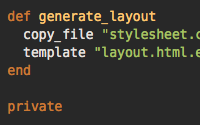Categories
- Active Record
- Active Resource
- Active Support
- Administration
- Ajax
- APIs
- Authentication
- Authorization
- Background Jobs
- Caching
- Code Walkthrough
- Controllers
- Debugging
- Deployment
- eCommerce
- Forms
- Mailing
- Models
- Performance
- Plugins
- Production
- Rack
- Rails 2.0
- Rails 2.1
- Rails 2.2
- Rails 2.3
- Rails 3.0
- Rails 3.1
- Rails 3.2
- Rails 4.0
- Refactoring
- Routing
- Search
- Security
- Testing
- Tools
- Views
Applied Filters:
rails_admin x
Active Admin
Active Admin allows you to quickly build an admin interface with just a few commands. Not only does it look great, but it is very customizable as shown in this episode.
(12 minutes)
Deploying to a VPS
Deploying a Rails application can be overwhelming because there are so many different options. Here I present a pattern for deploying a Rails app to a VPS using nginx, Unicorn, PostgreSQL, rbenv and more.
(18 minutes)
Active Model Serializers
The ActiveModel::Serializers gem can help you build JSON APIs through serializer objects. This provides a dedicated place to fully customize the JSON output.
(10 minutes)
Rubber and Amazon EC2
Deploying to Amazon EC2 allows you to scale an application quickly. Learn how to use Rubber to deploy to the cloud with just a few commands and monitor the cluster with various web tools.
(17 minutes)
Rollout and Degrade
Learn how to use the Rollout gem to deploy a feature to a select group of users and the Degrade gem to automatically disable it upon failure. Also included is a way of doing this from scratch.
(13 minutes)
Making Generators in Rails 3
Generators in Rails 3 have been rewritten to use Thor which means the code used to create a generator is quite different. Here you will learn the new way to make generators in Rails 3.
(10 minutes)
Semi-Static Pages (revised)
There are many ways to handle static pages in a Rails application. Here I show two approaches including one that uses a RESTful style PagesController to keep the content in the database
(8 minutes)
OAuth with Doorkeeper
Doorkeeper makes it easy to create an OAuth 2 provider. This episode also shows how to setup OmniAuth as an OAuth client and use the oauth2 gem to communicate with an API.
(19 minutes)
Securing an API
There are many approaches to locking down an API. Here I start off with HTTP Basic authentication then move on to generating a unique token which can be passed through a URL parameter or HTTP header.
(7 minutes)
Chef Solo Basics
Chef is a provisioning tool which allows you to spin up production servers automatically. Here I show how to get started with Chef Solo and create a custom cookbook.
(17 minutes)










